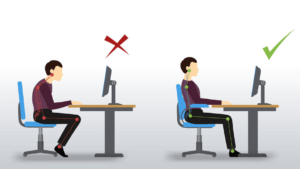Are you experiencing neck and shoulder pains?
Do you spend prolonged periods at your computer?

Have you checked your work station set up recently?
Most of us spend hours at our desk every day, for this reason it is important to create a supportive ergonomic work station to protect our health.
Prolonged sitting at a desk or computer, with poor work station set-up can aggravate or lead to work-related injuries, particularly in the neck, back and upper limbs.
Appropriate work station ergonomics can help to reduce fatigue and strain on the neck, shoulders, back and legs. Taking regular breaks throughout the day to walk around and stretch is important to minimise fatigue
Use the check list below to set up your work station.

- ELBOWS
Place your elbows above your desk resting them at 90-110°. Alternatively, you can place them at 90 on the arm rests of your chair. To maintain your elbows at 90° you may need to raise your chair and your feet may leave the floor. In this instance, it is helpful to use a foot stool.
2. SHOULDERS
Keep your shoulders in a relaxed position, trying to avoid a hunched posture. Align shoulders currently by drawing your shoulder blades up, backwards and then down from this position. They should naturally fall in the middle of your pelvis.
Supporting your forearms is important for your shoulders and neck to avoid sitting with rounded shoulders and placing unnecessary strain through these structures.
3. WRISTS
Keep your wrists in a neutral position. This means maintaining your hands parallel to each other and not angled inwards or outwards. This helps to reduce strain on the top and bottom of the wrists and fingers, as well as the outside of the elbow. In doing so, this can assist with symptoms of tennis elbow and carpal tunnel.
- HIPS, KNEES & ANKLES
It is important to maintain a neutral pelvic tilt while seated. This can be achieved by placing your hands on your hips, rotating them all the way forward, then rotating backwards as far as you can. The middle position is your desired pelvic position for sitting.
Keep your knees parallel to each other and resting at 90°. Maintain your ankles in a neutral position, resting your feet on the floor or a foot rest.
5. FEET
Flat on the ground or on a foot rest. For prolonged standing, consider using a standing mat.
6. HEAD
Maintain your head in a neutral position, upright with a slight chin tuck and your ears aligned with your shoulders.
Try to avoid sitting with your head in a forward of your shoulders (chin poke). This can place strain on the neck and shoulders.
7. EYES
To set the height of your monitor, make sure the top edge – not the middle – of the screen is in line with your eyes. This height will ensure you keep your neck in a neutral position. This position is recommended as it is easier to scan down with our eyes.
- SEAT LENGTH
Should be long enough to provide support beneath the thighs.
- BACKREST
Angled at 90-110° with adequate lumbar support in line with the lower back. This will be helpful to maintain the natural curvatures of your spine.
- KEYBOARD AND MOUSE
Align your nose with the G and H keys on the keyboard. Maintain a loose grip on the mouse.
- LAPTOP
If you are using a laptop as your main computer, it is advised that you invest in a laptop stand, external keyboard and mouse. It is preferable to raise the screen as high as possible to avoid unnecessary strain on the neck.

